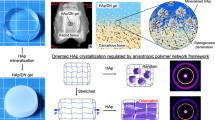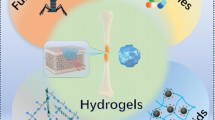Abstract
We have developed a new family of photopolymerizable, methacrylated anhydride monomers and oligomers that combine high strength, controlled degradation, and photoprocessibility in a singular system. Networks with degradation times ranging from 1 week to nearly 1 year and that retain up to 90% of their tensile modulus at 40% mass loss are attainable. In vivo studies in rats have shown that these networks possess excellent osteocompatibility. These combined properties could offer many advantages in medical applications ranging from dentistry to orthopedics.
This is a preview of subscription content, access via your institution
Access options
Subscribe to this journal
Receive 12 print issues and online access
$209.00 per year
only $17.42 per issue
Buy this article
- Purchase on Springer Link
- Instant access to full article PDF
Prices may be subject to local taxes which are calculated during checkout




Similar content being viewed by others
References
Kohn, D.H. and Ducheyne, P. 1992. Materials for bone and joint replacement, pp. 29–109 in Materials science and technology, Vol. 14. Medical and dental materials, Cahn, R., Haasen, P., Kramer, E. (eds.). VCH, Weinheim, NY.
Constantz, B., Ison, I.C., Fulmer, M.T., Posner, R., Smith, S.T., Van Wagoner, M. et al. 1995. Skeletal repair by in situ formation of the mineral phase of bone. Science 267:1796–1799.
Anseth, K.S., Newman, S.M., and Bowman, C.N. 1995. Polymeric dental composites: properties and reaction behavior of multimethacrylate dental restorations. Adv. Polym. Sci. 122:177–218.
Hill–West, J., Chowdhury, S., Sawhney, A., Pathak, C., Dunn, R., and Hubbell, J. 1994. Prevention of postoperative adhesions in the rat by in situ photopolymerization of bioresorbable hydrogel barriers. Obstet. Gynecol. 83:59–64.
Steinleitner A., Lambert, H., Kazensky, C., and Cantor, B. 1991. Poloxamer 407 as an intraperitoneal barrier material for the prevention of postsurgical adhesion formation reformation in rodent models for reproductive surgery. Obstet. Gynecol. 77:48–52.
Steinleitner, A., Lopez, G., Suarez, M., and Lambert, H. 1992. An evaluation of flowgel as an intraperitoneal barrier for prevention of postsurgical adhesion reformation. Fertil. Steril. 57:305–308.
Svaldi, D.C., Young, J.S., and Anseth, K.S. 1998. Initiation mechanisms for three dimensional photopolymerization of biodegradable networks, chemical and physical networks formation and control of properties, pp. 161–172 in The Wiley Polymer Networks Group Review Series, Vol. 1. te Nijenhuis, K. and Mijs, W.J. (eds.).
Tormala, P., Rokkanen, P., Laiho, J., Taraminmaki, M., and Vainionpaa, S. 1988. Material for osteosynthesis devices. US 4,743,257.
Daniels, A.U., Chang, M.K., and Andriano, K.P. 1990. Mechanical properties of biodegradable polymers and composites proposed for internal fixation of bone. J. Appl. Biomat. 1:57–78.
Svaldi Muggli, D., Burkoth, A.K., and Anseth, K.S. 1998. Crosslinked polyanhydride networks for use in orthopaedic applications: degradation behavior and mechanics. J. Biomed. Mater. Res. In press.
Hill, J.W. and Corothers, W.H. 1932. Studies of polymerization and ring formation. XIV. A linear superpolyanhydride and a cyclic dimeric anhydride for sebacic acid. J. Am. Chem. Soc. 54:1569.
Anseth, K.S., Decker, C., and Bowman, C.N. 1995. Real–time infrared characterization of reaction diffusion during multifunctional monomer polymerizations. Macromolecules 28:4040–4043.
Acknowledgements
The authors would like to thank the National Institutes of Health for its support of this work through a fellowship and grant to K.S.A. (AR4197) and the National Science Foundation for its support through a grant (BES–9619331) to V.R.S. and R.L. The authors would also like to thank Robert Padera for valuable assistance in the histologic analysis.
Author information
Authors and Affiliations
Corresponding author
Rights and permissions
About this article
Cite this article
Anseth, K., Shastri, V. & Langer, R. Photopolymerizable degradable polyanhydrides with osteocompatibility. Nat Biotechnol 17, 156–159 (1999). https://doi.org/10.1038/6152
Received:
Accepted:
Issue Date:
DOI: https://doi.org/10.1038/6152
This article is cited by
-
Investigation and characterization of time-dependent degradation of X-Ca-alginate aerogels for biomedical applications
Journal of Materials Science (2023)
-
Biodegradable materials for bone defect repair
Military Medical Research (2020)
-
Polymeric Biomaterials for Scaffold-Based Bone Regenerative Engineering
Regenerative Engineering and Translational Medicine (2019)
-
Formulation, Delivery and Stability of Bone Morphogenetic Proteins for Effective Bone Regeneration
Pharmaceutical Research (2017)
-
Production, characterisation, and cytocompatibility of porous titanium-based particulate scaffolds
Journal of Materials Science: Materials in Medicine (2013)



